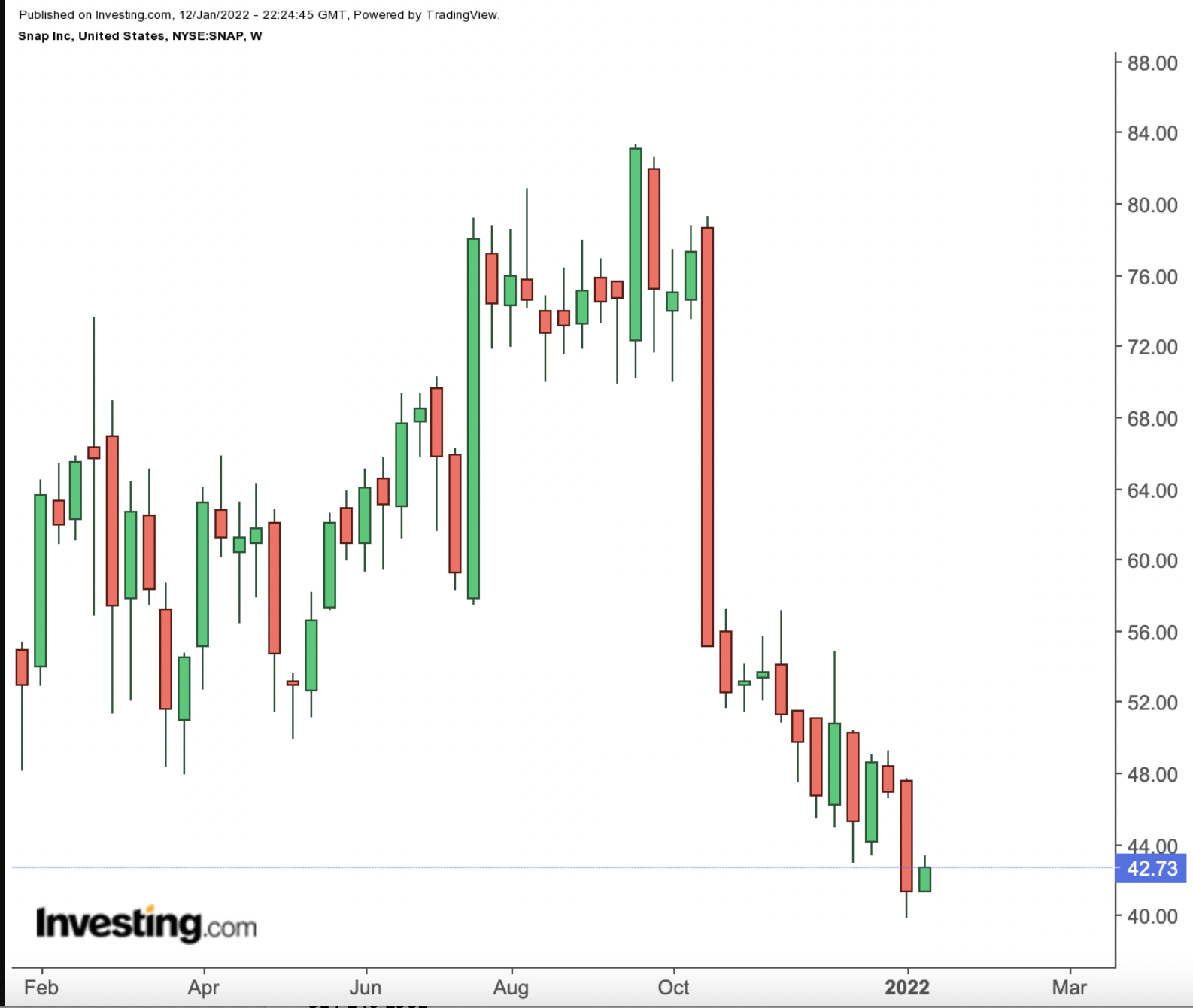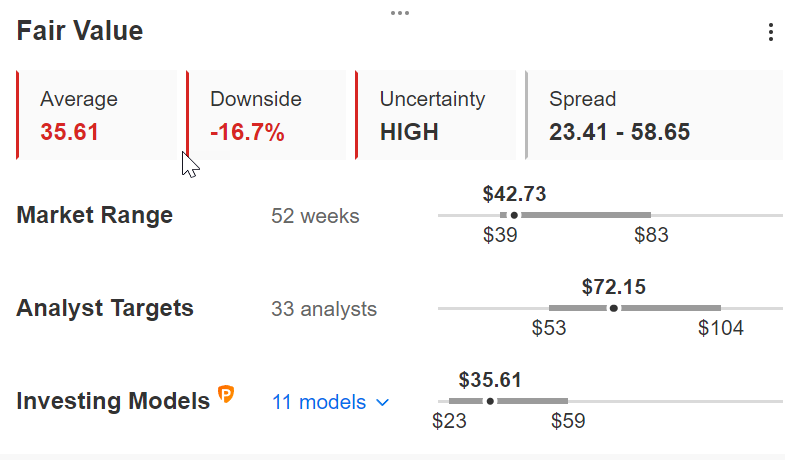- Social media SNAP stock lost more than 23% in the past 12 months
- With 306 million daily active users, Snap is one of the most popular social networks among teenagers
- Long-term investors could consider buying the dips in SNAP shares, especially if they decline below $40
Investors in social media group Snap (NYSE:SNAP) did not have a good 2021. In the past 12 months, shares declined more than 23%. In fact, just since the start of 2022, SNAP has lost over 6%. The stock closed on Wednesday at $42.73.

Yet, on Sept. 24, 2021, SNAP shares saw a record high of $83.34, which means that in less than four months, they have lost about 47%. The stock's 52-week range has been $38.51 - $83.34, while the market capitalization stands at $70.4 billion.
Launched in 2011, Snapchat is one of the most popular social network platforms among teenagers. The app currently has 306 million daily active users, with close to two-thirds of those users living outside of North America. Like other social media platforms, most of Snap’s revenue comes from selling ads. Therefore, growth in daily active users remains one of the most important metrics Wall Street watches.
Recent metrics suggest:
“Ad spending in the social media advertising segment is projected to reach $62,998m in 2022.”
By 2026, the market is expected to reach almost $90 billion, showing a compound annual growth rate (CAGR) of 8.80% between 2022-2026.
Management announced Q3 metrics on Oct. 21. Revenue was $1.07 billion, up 57% year-over-year. Management highlighted that iOS privacy changes made by Apple (NASDAQ:AAPL) negatively affected ad revenue.
Meanwhile, net loss declined to -$72 million. A year ago, it had been -$200 million. Adjusted EPS was 17 cents. Snap added 13 million daily users during the quarter, up about 23% YoY.
On the results, CEO Evan Spiegel said:
“We’re now operating at the scale necessary to navigate significant headwinds, including changes to the iOS platform that impact the way advertising is targeted, measured and optimized, as well as global supply-chain issues and labor shortages impacting our partners.”
Investors have recently hit the brakes on many growth names, and Snap has been one of them. Before the release of the quarterly results, shares were around $75. The following day, they opened below $60. On Jan. 10, SNAP stock hit a 52-week low of $38.51.
What To Expect From Snap Stock
Among 39 analysts polled via Investing.com, SNAP stock has an “outperform" rating.
Analysts also have a 12-month median price target of $73.75 on the stock, implying an increase of close to 72% from current levels. The 12-month price range currently stands between $53 and $104.

Chart: Investing.com
However, according to a number of valuation models, like P/E or P/S multiples or terminal values, the average fair value for SNAP stock via InvestingPro stands at $35.61, implying a potential decline of almost 17%.

Moreover, we can look at the company’s financial health determined by ranking more than 100 factors against peers in the communication services sector. In terms of growth health, Snap scores 4 out of 5 (top score). Yet, concerns over its cash flow and profitability push down its overall performance rating to “fair.”
At present, P/B and P/S ratios for SNAP stock are 29.9x and 18.3x, respectively. By comparison, those metrics for its peers stand at 3.1x and 8.0x.
And if we look at two other social media giants, we can note that even for a growth stock, Snap has a frothy valuation. Comparable numbers for Meta Platforms (NASDAQ:FB) are at 7.0x and 8.3x. For Twitter (NYSE:TWTR), they stand at 4.5x and 6.7x.
We expect SNAP stock to continue to be volatile through to the end of the month, before management announces Q4 results in early February. Both SNAP and its social media peers could come under pressure if Wall Street is not pleased with overall results from the segment. In that case, we could possibly see Snap shares go below $40 once again.
Nevertheless, despite any potential short-term decline, we’re bullish on SNAP in the long run.
Adding Snap Stock To Portfolios
SNAP bulls with a two- to three-year horizon who are not concerned about short-term volatility could consider buying the stock around these levels for long-term portfolios. The target would be $73.75, the analysts' consensus expectation.
Alternatively, investors could consider buying an exchange traded fund (ETF) that has SNAP as a holding. Examples would include the:
- Simplify Volt Pop Culture Disruption ETF (NYSE:VPOP)
- Global X Social Media ETF (NASDAQ:SOCL)
- Invesco Dynamic Software ETF (NYSE:PSJ)
- Roundhill Ball Metaverse ETF (NYSE:META)
Finally, investors who believe SNAP stock could continue to reach new highs in the early part of the new year might consider selling a cash-secured put option in Snap stock—a strategy we regularly cover. As it involves options, this setup is not appropriate for all investors.
Cash-Secured Put Selling
Such a bullish trade could especially appeal to those who want to receive premiums (from put selling) or to possibly own SNAP shares for less than their current market price of $42.70 at the time of writing intraday Wednesday.
A put option contract on Snap stock is the option to sell 100 shares.
Let's assume an investor wants to buy SNAP stock, but does not want to pay the full price of $42.70 per share. Instead, the investor would prefer to buy the shares at a discount within the next several months.
One possibility would be to wait for Snap stock to fall, which it might or might not do. The other possibility is to sell one contract of a cash-secured SNAP put option.
So the trader would typically write an at-the-money (ATM) or an out-of-the-money (OTM) put option and simultaneously set aside enough cash to buy 100 shares of the stock (hence “cash secured”).
Let's assume the trader is putting on this trade until the option expiry date of Mar. 18. As the stock is $42.70 at time of writing, an OTM put option would have a strike of $40.
So the seller would have to buy 100 shares of SNAP at the strike of $40 if the option buyer were to exercise the option to assign it to the seller.
The SNAP Mar. 18 40-strike put option is currently offered at a price (or premium) of $3.25. An option buyer would have to pay $3.25 X 100, or $325, in premium to the option seller. This premium amount belongs to the option seller no matter what happens in the future. The put option will stop trading on Friday, Mar. 18.
Assuming a trader would enter this cash-secured put option trade at $42.70 now, at expiration on Mar. 18, the maximum return for the seller would be $325, excluding trading commissions and costs.
The seller's maximum gain is this premium amount if SNAP stock closes above the strike price of $40. Should that happen, the option expires worthless.
If the put option is in the money (meaning the market price of Snap stock is lower than the strike price of $40) any time before or at expiration on Mar. 18, this put option can be assigned. The seller would then be obligated to buy 100 shares of SNAP stock at the put option's strike price of $40 (i.e., at a total of $4,000).
The break-even point for our example is the strike price ($40) less the option premium received ($3.25), i.e., $36.75. This is the price at which the seller would start to incur a loss.
Cash-secured put selling is a moderately more conservative strategy than buying shares of a company outright at the current market price. This can be a way to capitalize on any choppiness in Snap stock in the coming weeks, especially around the earnings announcement.
Investors who end up owning SNAP shares as a result of selling puts could further consider setting up covered calls to increase the potential returns on their shares. Thus, selling cash-secured puts could be regarded as the first step in stock ownership.
